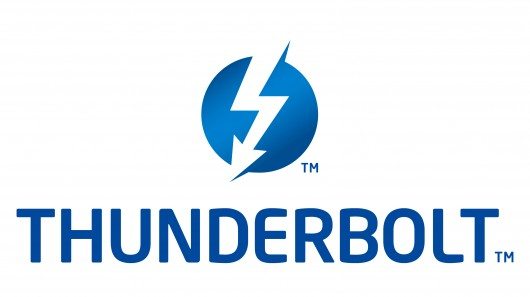Thunderbolt is the latest I/O interface for MacBook Pro, and stands to shake up the historically bad rap MacBook Pro has received with its longterm roadmap.
Thunderbolt is nice because
- Built from the ground up for audio and video professionals
- Two bi-directional channels of up to 10Gbps (that’s 1.25 gigabytes per second)
- 10Gbps of usable bandwidth, not a theoretical maximum or burst speed
- Intel aims to increase this to 100Gbps within a decade
- Up to seven devices can be daisy chained to a single Thunderbolt port
- Low latency, time synchronized (to within eight nanoseconds) transfers down the entire seven-device chain
- Connected peripherals appear as PCI Express or DisplayPort devices to the operating system, avoiding potential driver issues
- Uses copper cables with a maximum length of 3 metres, with a switch to backwards-compatible optical technology on the horizon
- 10 watts of power per port available to connected peripherals (versus USB’s 5 watts)
- Powered devices in the daisy chain can pass another 10 watts down the chain
- Uses the Mini DisplayPort connector
- Compatible with existing DisplayPort monitors and adapters (HDMI, DVI and VGA)
- Compatible with USB, FireWire, eSATA and other existing PCI Express-based protocols via adapters
- No licensing fees for peripherals (unlike FireWire)
There are many professional users of Apple products who rely on expensive external peripherals to do their jobs, and since 2008, they’ve all been watching Apple slowly remove the ports they need to connect those peripherals. The fastest I/O available on a 2010 MacBook Pro 15″ was an eight-year-old FireWire 800 port, while PC users enjoyed ExpressCard/34, eSATA and USB 3.0 – each several times faster than FireWire 800. People developed genuine concerns that Apple was drunk on the massive profits of its iOS business and would let its professional business (including its Final Cut and Logic software packages) die a slow death while it chased the mass market dollar.
Thunderbolt is the antidote. It’s a sign that that pros still matter, it’s superior in every conceivable way, and it’s compatible with all that existing gear. There’s no existing use case that can completely saturate that 10Gbps link and that is exactly the point. An I/O interface shouldn’t be the bottleneck in your system.
And it’s not just for professionals. In an era of 10+ megapixel point-and-shoot cameras, 1080p camcorders and multi-terabyte collections of pirated media, I think you’d be crazy to suggest that only A/V professionals will benefit from blazingly fast I/O.
Thunderbolt devices are already being announced, such as LaCie’s Little Big Disk with Thunderbolt, and several high-profile A/V and storage companies have voiced support for the new interface including Aja, Apogee, Avid, Blackmagic, LaCie, Promise, Universal Audio and Western Digital.






